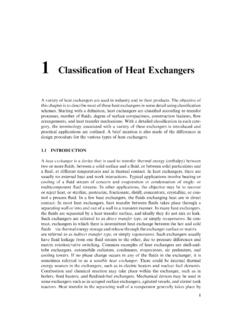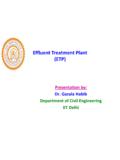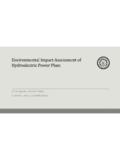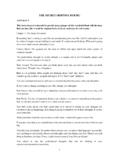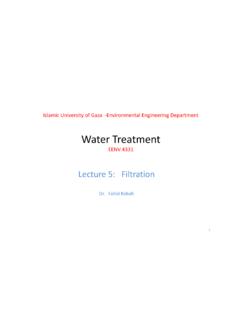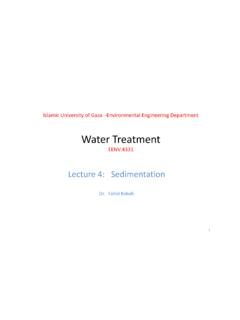Transcription of Lecture 8: Water treatment processes
1 January 28, 2015 Arun Kumar 27th2015)by Dr. Arun Kumar 8: Water treatment processesObjective: Understand functioning of different unit processes for Water treatmentCourtesy: Dr. Irene Xagoraraki (Michigan State University, East Lansing, USA)Previous Lecture re-cap Introduction of Water treatment schematic concepts Discussion on production of Water of different final usages Discussion on checks Remove solids before removing bacteria Remove solids using sedimentation process before using filtration Remove organic compounds and ammonia-based compounds before disinfection Discussion on need for calculating solids waste produced from every unit processes and solid waste managementExample 2.
2 River Water Drinking waterJanuary 28, 20153 Example 2 schematic 28, 20154 treatment schematic (SW Potable drinking Water ) Sequence of unit processes : pre-sedimentation mixing, flocculation ,settling filtration adsorption disinfection Function of unit processes : solids removal removal of ions, and solids using chemicaladdition removal of smaller particles removal oforganic compounds and ions oxidation of oxygen-demandingwastesandchemicalkilling ofpathogens in waterJanuary 28, 20155(SW Potable drinking Water ) Chlorine is added in sedimentation and filtration tank to avoid microbial growth Chorine is used as a oxidizing agent as well as a disinfection 28, 20156 Surface Water TreatmentConventional Surface Water treatment Screening (remove relatively large floating andsuspended debris)
3 Rapid-mix (mixing Water with chemicals thatencourage suspended solids to coagulate intolarger particles that will settle easily) flocculation (gentlymixingwaterandcoagula nt allowing the formation of largeparticles of floc)Conventional Surface Water treatment Sedimentation (flow is slowed enough so thatgravity will cause flocs to settle) Sludge processing (mixture of solids andliquids collected from settling tank aredewatered and disposed of) Disinfection (ensure that Water is free ofharmful pathogens) Distributionsystemprotection(residualdis infection)Solids removalJanuary 28, 201510 Method Sedimentation Solids settle based on their gravitational force (with andwithout externally added chemicals).
4 Settling depend on solid physical characteristics(diameter, density) and medium temperature, viscosity,density, etc. Some solids do not interact with each other duringsettling ( , discrete particles) (no change in their sizeand shape). The settling is called discrete settling (Type1 settling). Ex: settling of 28, 201512 Method1. Sedimentation Some solids interact during their settling and changetheir size and shape ( , flocculent particles) (Type 2settling). Ex: settling of clay; 28, 201513 Sedimentation Time for settling = column depth/settling velocity atsteady state Some particle take less time and some particles takelonger time to settling.
5 If t_design>t_settling, particles remove 100%. All patciesnow constitute to solid waste. if t_design<t_settling, particles do not remove 100%.Remaining particles go to next unit in treatment 28, 201514 Method 2. coagulation - flocculation -SedimentationSo me coagulants: aluminum sulfate,ferric sulfateferric chlorideSome coagulant aids:activated silicaclaypolymersCoagulation-Flocculati on-SedimentationFull-scalePilot-scaleBen ch-scaleSizes of Particles in WaterMethod2. coagulation - flocculation (sedimentation after chemical addition) Some solids take very long time to settle (size insubmicron range or in nanometer range).
6 Chemicals (ex: alum; ferric chloride) are added insolution to (1) increase size of particles, (2) capture themin hydroxide flocs and then precipitate 28, 201518 coagulation - flocculation ++++++++++++++++++++++++++++ ++++++++Colloidal particles( - 10 m)floc(1 - 100 m)Method2. coagulation - flocculation (sedimentation after chemical addition) coagulation methods: (i) ionic layer compressions, (2)charge neutralization and surface complexation, (3)sweep coagulation (iv) polymeric bridging Ex: ferric chloride gives ferric ions (acidic pH) and ferrichydroxide (basic pH).
7 These species work in 2 differentways to improve particle 28, 201520 coagulation - flocculation Double Layer Compression Adsorption of Aluminum to Produce Charge Neutralization Interparticle Bridging Enmeshment in Al(OH)3 Precipitate (sweep floc)Picture Source: Malvern Instruments, Zeta-Meter MixingFlocculation(Source: Water Supply and Pollution Control, 5thed. W. Viessman, Jr. and Hammer, Harper Collins College Publ. 1993)SedimentationQuestion 1: GDW to Gardening Water Which parameters do we need to remove? Which unit processes do we need for makinggardening Water from groundwater?
8 Is the orderof unit process relevant here? How does the schematic of treatment of GDW toGardening Water differ with that of GDW-Drinking Water ?January 28, 201526 Question 2: Injection of gardening Water runoff in soil:Requirements? Can we inject garden Water runoff to soil? Which parameters do we measure? Do we need to do treatment before we can injectthe Water ( , pretreatment)? Will it depend on soil type, depth to Water table, 28, 201527 Question 3: Comparison Why schematic for GDW DW and SW DWdiffer? Can one treatment plant treat GDW as well asSW for producing DW?
9 January 28, 201528 Question 4: Domestic WW to Water suitable for discharge to river Can you draw schematic for treating domesticwastewater to produce Water suitable fordischarge to river?January 28, 201529 Answer 4: Domestic wastewater Discharge Water to river Sequenceofunitprocesses:stabilizationtan k sedimentation biologicalprocess secondrysettling nitrifierunit denitrifier unit disinfection discharge watersuitable for river Function of unit processes : making incoming flowrate uniform solid removal breakdown of organiccompound settlingofmicrobialbiomass removal of ammonium ions removal of nitrateions killing of microorganismsJanuary 28, 201530 treatment schematic (GW Potable drinking Water ) Sequence of unit processes .
10 Aeration chamber Softening unit Filtration with chlorination Disinfection Function of unit processes : Gas removal cations and solids removal solids removal microbial removal Lime, soda ash and chlorine are required daily. Solid waste generated from softening unit and filtration unit are calculatedJanuary 28, 201531 Next 28, 201532



